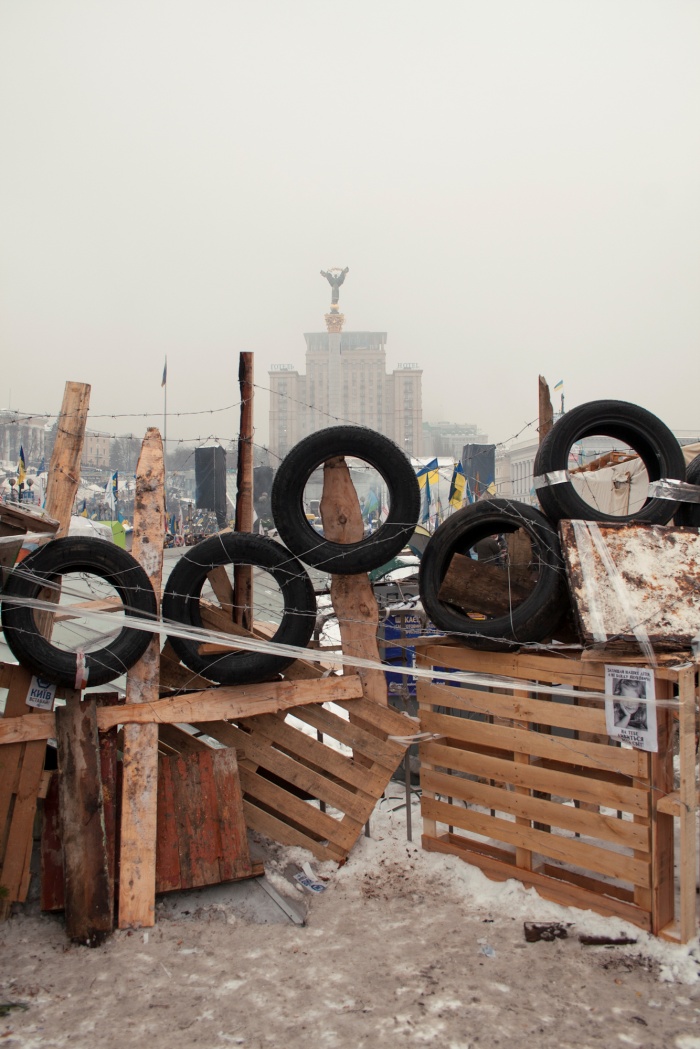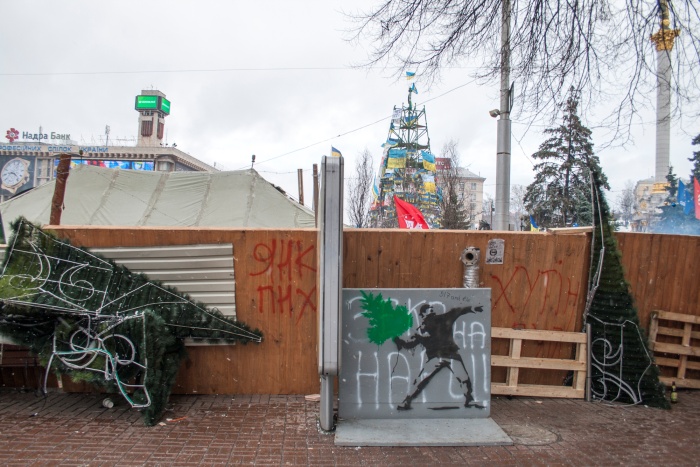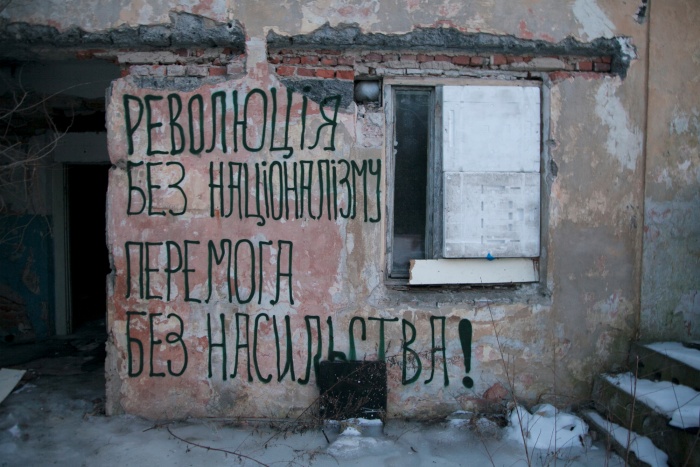Over the course of the past decade Ukraine endured social and political transformations, marking the end of a long post-communist transition period. It reached its climax with the social upheaval of 2013-2014 that were often claimed to be a birth of a modern civic society or the new Ukrainian subjectivity.1 While being predominantly self-coordinated through Facebook, the protest held to a particular physical location of Kyiv’s Maidan Nezalezhnosti (Independence Square), and later the word “maidan” has become a synonym for ideas of gathering in public space for social practices based on human rights and social solidarity. Such a level of engagement with public space signaled a paradigmatic shift in its popular perception: from obedience disciplined by the Soviet era and commercialization/mass entertainment promoted by newly emerging neoliberal economy — to the active involvement in political articulation and personal responsibility. These differing paradigms manifest themselves through ideological underpinnings embedded in spatial organisation of Kyiv’s central square and in the post-Maidan decommunization rhetoric, both being in discrepancy with the recent engagement with public space as a place for experimentation and action.

Sasza Kurmaz, z serii Ukraina. Przestrzeń możliwości [Ukraine: A Space of Possibilities], 2013–14. Napis głosi: "Siedzenie na Facebooku jest kontrrewolucyjne". Dzięki uprzejmości autora.
Projections
The spatial organization of Kyiv’s center provides a perfect historical and ideological background. The design of the city’s administrative center took place in the 1930’s following the logic of the only allowed artistic method of Socialist realism.2 The latter appropriated the Soviet avant-garde’s idea that human beings are malleable. Soviet culture under Stalin was a culture for masses that had yet to be created.3 Already in 1919 Vladimir Tatlin, who taught in Kyiv Academy of Arts, proposed the idea of an all-encompassing “monument of a new type”: a gigantic functional sculpture seen from everywhere and used both as a lectorium and a platform for dissemination of agitation and propaganda — projected on clouds, leaflets or through radio waves penetrating the city.4 Stalinist urban planning favoured such gigantic edifices that would merge aesthetics and politics for ideological education of the ‘masses’, while simultaneously reinforcing the power vertical through omnipresent monumental figures of ‘vozhd’.5
The reconstruction of Kyiv’s center was “deeply political nature”6 instrumentalizing the aesthetics in a similar way. With Hotel Moskva erected on a square and three monumental Lenin figures guarding its perimeter — the space was both to remind about the centrality of power and to shape the masses accordingly. Soviet architects were also tasked with functioning as “social architects” of the regime and, as such, creating ceremonial monuments and parade squares, public spaces that, under the slogan of “All belongs to the people” were actually meant to appropriate the public experiences of citizens through amassing large numbers of people within the public space and allowing the government to monitor and assess citizens en masse. In this context, totalitarian and authoritarian regimes use of the concept of “masses” not so much in order to create a feeling of belonging and interconnectedness among citizens based on shared memories, traditions, and history as to establish a mechanism of “belonging” to the extraterritorial, incorporeal Soviet “collective body.”7

Sasza Kurmaz, z serii Ukraina. Przestrzeń możliwości [Ukraine: A Space of Possibilities], 2013–14. Dzięki uprzejmości autora.
Despite this, the reconceptualisation of Maidan as an ‘ideal public space’ took place in the 80’s when it was appropriated through shared social practices. Regardless of the season, people would gather here to discuss political events or pressing social issues.8 Since then it has witnessed several important democratic protests; to break one of those —2000’s Ukraine Against Kuchma—the government decided to redesign the square, commenting on its massive potential as a commercial and entertainment complex. A giant shopping mall was constructed beneath and around the square to “motivate citizens to earn more”.9 Such commercialization of the public space as governmental strategy of the era of “building crony capitalism” eclipsed the previous Soviet strategy of control and education of an ideologically “correct” collective body using the public space as a tool. The protest took place against this backdrop: in between massive Soviet edifices surrounding the square as embodiment of totalitarian regime, and luxurious shopping mall signifying the neoliberalization of independent Ukraine beneath it.
Platforms
The idea of a city and public space as a place for political deliberation and participation fundamental for democracy is well articulated— form Greek agora to the ‘right to the city’.10 Yet in the context of the Maidan, the notion of public space has already broadened: in Ukraine, an extensive use of Facebook provided a prototype of a democratized platform giving voice to proliferation of opinions. As opposed to an overall popular withdrawal from public sphere largely controlled by oligarchic media, Facebook enabled exchange of thoughts and later on coordination of the grassroot initiatives. It was a Facebook post that quickly mobilized people to come to the square, which had already become a metaphor for civic consciousness.
Remarkably, one of the first articulated demands of protesters was for the right to use the city and its public places to assemble: following brutal police attacks on protesters and the government’s attempts to clear the square with an argument that it needs to be cordoned off for the instalment of the New Year tree — Maidan square was quickly transformed into an extemporaneous town protected by barricades made of debris and collectively decorated for the holidays. The metal carcass of that unfinished tree was reminiscent of the aforementioned Tatlin’s monument, functioning, instead, as an open platform to project not one but multiple messages. The protesters further claimed access to the administrative buildings and occupied them for their needs. While not having a coordinator at large, it grew as a rhizome, with self-organized initiatives defined by what was important for a particular group with the latter representing full political spectrum from left to right.
Here, the plurality of social life and thought manifested itself through means of creative expression and forms of cooperation in the city became a country-wide phenomenon that signalled popular engagement with social and political issues. The fully functioning and diverse entity of the Maidan formed a background for the emergence of a public sphere in the Habermasian sense—as a place where citizens could assemble and unite, express and publicize their opinions freely, and as a regulatory institution against the authority of the state.

Sasza Kurmaz, z serii Ukraina. Przestrzeń możliwości [Ukraine: A Space of Possibilities], 2013–14. Dzięki uprzejmości autora.
The protest agenda addressing widespread government corruption, abuse of power, and human rights violations in Ukraine had been widely communicated in Kyiv’s both physical and digital public space through street art and graffiti, DIY posters and stickers that were available on the internet for print to further circulate messages ranging from “human rights above all” to appropriated slogans from France’s May 1968 social revolution. Nonetheless the media portrayal of Maidan has been largely reduced to a monolithic representation of identity, militancy, or the upholding of nationalist ideology, political activism of that period seemed to be value oriented, focusing on principles such as dignity, freedom, solidarity, cooperation, social responsibility and celebration of multiculturalism in a diverse land.”11 With a diversity that manifested itself through a variety of ethnicities, languages, cultures, religions, and political views, the Maidan became a multitude that unified a plethora of individuals under the same cause, yet with various agendas that resist any kind of a uniformed image.

Sasza Kurmaz, z serii Ukraina. Przestrzeń możliwości [Ukraine: A Space of Possibilities], 2013–14. Napis głosi: "Rewolucja bez nacjonalizmu; zwycięstwo bez przemocy". Dzięki uprzejmości autora.
Pedestals
The complexity of these protest narratives, however, has not been addressed in the official post-Maidan discourse taken over by the reactivated Institute of National Memory, alarming in its misrepresentation of the grassroots formation of a democratic public sphere during the protest. While making a controversial argument around ‘Sovietness’ being a decisive factor in the protest and subsequent military conflict in Crimea and Donbass, the Institute contributed to casting the events as nationalist and anti-colonial revolution, thus shifting the focus towards identity and memory and overshadowing debates about the actual causes of the Maidan. The nationalist agenda was neither primary nor dominant during the Maidan, rather the opposite Maidan, was focusing on constructing a new society rather than litigating the past colonial experience, with common values that constitute the “new, hybrid and inсlusive Ukrainianness.”12
With a precedent set in later 2013 when the Lenin monument in Kyiv was toppled down following the disclosure of Russian interference in Ukrainian politics, the Institute further passed controversial “decommunization laws” (2015) that equated Soviet and Nazi regimes and criminalized any visual symbols representing ideas of communism or the respective era.13 The explanatory note to the law stressed that it did not require a public discussion; thus, such an approach repeated the Soviet model of decision making in which a few people define the correct idea of use of the public sphere, make their decision behind closed doors, and announce that any disagreement may be categorized as a criminal act. This radical sweep of the law and the uncompromising attitude of the government form a drastic contrast with the inclusive openness of the Maidan, as demonstrated by regular gatherings on the square to discuss pertinent issues in ‘viche’ public assemblies and through forms of expression that transcended fixed identities.14 Furthermore, the very emphasis on the formative power of monumental art and public space in ideologically ‘upbringing’ of people engages in the same logic against which these laws were ostensibly designed.
Last but not least, this drastic discrepancy between an emerging grassroots process of social and cultural pluralism, and the government’s misleading and autocratic attempts to monopolize public space further manifested itself as the empty pedestal of the former Lenin monument has become a site for artistic interventions that demonstrated a different mode of engagement with public space. Ranging from anonymous hijacking of the spot with DIY sculptures such as golden toiled, kitschy garden figures of Mother Mary or Jedi Master Yoda, to elaborate artistic projects curated through open calls and considerations of popular opinions — what was common to all of these interventions were the irony and fearless occupation of public space in contrast to the restrictive and almost sacralized Soviet approach to the monuments. It is this kind of engagement that signals pluralization of public sphere and facilitates voices and agendas that need their platform, for which new diverse narratives are yet to be written.
BIO
Asia Bazdyrieva is an art historian and researcher at Geocinema (https://geocinema.network) — a series of cinematographic investigations that examine infrastructures of earth-sensing data as forms of cinema. She co-authors the project together with filmmaker Solveig Suess. Their current work focuses on the history of remote sensing and the ways it contributes to epistemology and the political regimes it enables. Bazdyrieva’s professional experience of the past decade revolves around writing, research, and educational work both independently and within various cultural institutions internationally. She holds a Master’s degree in art history from the City University of New York and analytical chemistry from the Kyiv National University. In 2018, she was a postgraduate in The New Normal urban design think-tank at the Strelka Institute for Media, Architecture, and Design (Moscow). Lives a nomadic life, yet always comes back to Berlin and Kyiv.
*Cover photo: Sasha Kurmaz, from the series Ukraine: A Space of Possibilities, 2013–14. Courtesy of the author.
[1] Ilya Gerasimov, Ukraine’s Postcolonial Revolution and Counterrevolution, paper delivered at the conference "Revolution und Krieg: Die Ukraine in den grossen Transformationen des neuzeitlichen Europa / Revolution and War: Ukraine and the Great Transformation of Modern Europe," Berlin, May 28, 2015, https://www.academia.edu/25025782/Ukraines_Postcolonial_Revolution_and_Counterrevolution.
[2] The capital of the Ukrainian Soviet Socialist Republic moved here from Kharkiv that had been the 1919-1934 capital because Kyiv was considered anti-Soviet: Moscow officials would not risk having a government there until all Ukrainian independence movements had been brutally repressed.
[3] Boris Groys, Gesamtkunstwerk Сталин (Ад Марингем Пресс: 2013), 6.
[4] Boris Yerofalov-Pilipchak, Архитектура советского Киева (Architecture of Soviet Kyiv) (Kyiv: A+C, 2010), 23-26.
[5] The exemplary model for creation of symbols of power in the public space of Soviet cities was the competition for the design of the future Palace of Soviets—a government centre in the middle of Moscow, which was meant to become the tallest building in the world at the time. The winning project, designed by Boris Iofan, became a canonical example of Utopian Totalitarian architecture: a building 1378 feet in height, to be crowned with a grandiose monument to Vladimir Lenin. The outer appearance of the building was to resemble a pyramid, the apex of which would be the figure of “vozhd” (the leader) as Lenin was known in Soviet times. As such, the project is a lasting visual illustration to the Soviet concept of the “power vertical.” According to plans, the building was meant to be clearly visible from a distance of up to 22 miles. That is to say, even from a great distance, the people were to be able to gaze up from the ground at the figure of their supreme leader— a symbolic manifestation of Soviet power dynamics between the people and the government.
[6] P. Yurchenko, cited in Yerofalov-Pilipchak, Architecture of Soviet Kyiv, 167.
[7] Ihor Tyshchenko and Svitlana Shlipchenko, Maidan: vid prostoru protestu do ‘urbanistychnoho spilnoho’. Yak tvorylasya urbanistychna evtopiya [“Maidan: from the ptotest space to ‘urban commons.’ How the urban utopy had been created”] in (Ne)zadovolennya publichnimi prostoramy [(Dis)satisfaction with public spaces] (Kyiv: Vsesvit, 2017): 98.
[8] Ibid.
[9] When discussing the reconstruction of the Maidan, Sergey Babushkin, businessman and main Kyiv architect from 1996 to 2003, said that the square and especially its subterranean areas had massive potential as a commercial and entertainment complex. He also noted that both Ukrainian and foreign investors were enlisted in order to rebuild the square and construct a shopping mall, adding that the possibility of using the Khreschatyk to earn money should serve as a motivating factor for citizens.
[10] For the lack of space I did not mention David Harvey’s contribution to the discourse around democracy and public space. Here I refer to his The Political Economy of Public Space, http://davidharvey.org/media/public.pdf
[11] Grace Mahoney, God and a Can of Spray Paint Are With Us: Post-Revolutionary Activist Street Art in Ukraine, KRYTYKA, August 2016, accessed December 16, 2016, https://krytyka.com/en/articles/god-and-can-spray-paint-are-us-post-revolutionary-activist-street-art-ukraine.
[12] Ilya Gerasimov, Ukraine’s Postcolonial Revolution and Counterrevolution, paper delivered at the conference "Revolution und Krieg: Die Ukraine in den grossen Transformationen des neuzeitlichen Europa / Revolution and War: Ukraine and the Great Transformation of Modern Europe," Berlin, May 28, 2015, https://www.academia.edu/25025782/Ukraines_Postcolonial_Revolution_and_Counterrevolution.
[13] Full text of decommunization law: Legislation of Ukraine, accessed on February 17, 2020, https://zakon.rada.gov.ua/laws/show/317-19?lang=uk.
[14] ‘Viche’ (‘veche’) is an old slavic word for town’s meeting or popular assembly. In Medieval times in Kievan Rus, vіche was the prototype of the self-rule. During the Maidan, viche became a protest tradition: every Sunday thousands of people gathered at the Maidan square to hear reports from opposition leaders, opinion makers, etc., and discuss the current situation.



